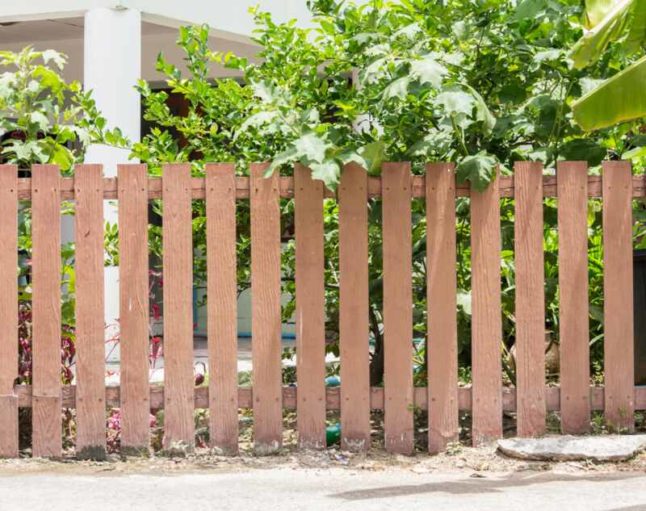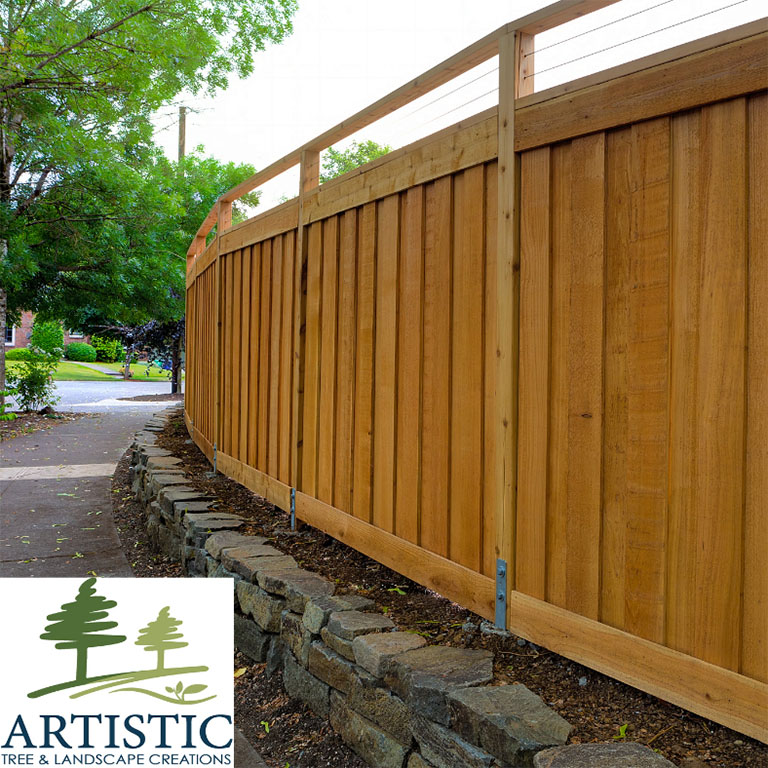All Categories
Featured
From hefty rain and snow to intense sun and wind, weather-related damages is one of the most typical causes of fencing wear and tear. While you can not regulate the climate, there are a number of methods to secure your fencing from the damaging impacts of weather condition and guarantee it lasts for years to come.
Wood Fences: While wood fencings are a timeless selection, they are extremely susceptible to wetness and parasites. To make a timber fence more durable, choose for pressure-treated lumber, cedar, or redwood. These products are a lot more immune to rot and insects. Nevertheless, you'll still need to safeguard the timber from the aspects with normal upkeep.
Vinyl Fences: Plastic fencings are very durable and need little maintenance. They are immune to fading, splitting, and bending, making them suitable for regions that experience severe sun, rain, or winter. Vinyl likewise will not rot or bring in parasites, offering long-lasting security without the demand for continuous upkeep.
Steel Fences: Wrought iron and aluminum fences are excellent selections for their strength and resistance to wind and wetness. Nevertheless, they are susceptible to rusting in time, particularly if subjected to constant rains or humidity. Choose galvanized or powder-coated steel fences to reduce the risk of rust.
![]()
Composite Fences: Integrating wood fibers and plastic, composite fencings are immune to decomposing, fading, and insect damages. They provide the look of timber with less maintenance, making them an excellent choice for locations with variable weather.
![]()
Wooden Fencings: A top quality wood sealant or tarnish is necessary to protect your fence from the aspects. Wood sealants block dampness and shield versus mold and mildew and mildew development. They also avoid UV damage that can trigger fading and splitting. Be certain to reapply the covering every couple of years to keep your fence top condition.
Plastic Fences: While vinyl is low-maintenance, you can still safeguard it even more by using a UV protectant. These finishes help avoid discoloration triggered by long term sun direct exposure. Furthermore, utilize vinyl-specific cleaners to keep the surface area totally free of stains or dirt buildup.
Steel Fencings: To secure steel fences from rust and deterioration, take into consideration applying a rust-inhibiting primer complied with by a protective paint developed for outdoor usage. Ideally, powder coating provides a durable and durable coating that can stand up to severe climate.
Wood Fencings: Tidy your wooden fence with a pressure washer or a soft towel and light cleaning agent. Examine the fence routinely for signs of rot, splits, or insect invasions.
Vinyl Fences: Plastic fencings are very easy to tidy with soap and water. For tougher stains, you can make use of a mild bleach option or a plastic cleaner to restore the fencing's look. Don't fail to remember to inspect for any type of splits that may allow water in, leading to additional damages.
Steel Fencings: Clean steel fencings with a soft fabric to eliminate dirt, rust, and dust. If you notice corrosion areas, eliminate them promptly with a cord brush and deal with the location with a rust-resistant primer or paint to prevent it from spreading.
Wood Fencings: When installing wooden fencing posts, make certain they are established deeply into the ground, preferably listed below the frost line to protect against shifting throughout freezing temperature levels. Use concrete to secure the messages and prevent them from being or leaning uprooted by solid winds.
Steel Fencings: For metal fences, guarantee that the articles are strongly anchored in concrete. This is specifically vital in regions with hefty winds or constant storms. You may also intend to mount extra supporting to give added assistance against wind stress and anxiety.
In addition, extreme moisture from neighboring plants can cause mold and mildew and rot in wood fences, so maintain greenery at a risk-free range to permit appropriate airflow and water drainage.
Metal fences ought to be inspected for corrosion prior to the winter months period begins, and any impacted areas ought to be treated with rust-resistant products. In addition, using a layer of paint or protective layer prior to the chilly climate sets in can assist protect your fence from ice and snow damages.
![]()
Verdict. Safeguarding your fence from weather-related damage calls for a combination of proper product option, regular maintenance, and positive treatment. Whether you have a wooden, vinyl, steel, or composite fencing, the right protective measures can prolong its life expectancy and maintain its look. By complying with these straightforward yet efficient actions, you can protect your fence versus the elements and maintain it looking terrific for several years to find.
- Pick Weather-Resistant Materials. Among one of the most efficient ways to protect your fencing is by choosing the appropriate product for your climate. Particular materials are more resilient and much better matched to withstand particular weather conditions.
Wood Fences: While wood fencings are a timeless selection, they are extremely susceptible to wetness and parasites. To make a timber fence more durable, choose for pressure-treated lumber, cedar, or redwood. These products are a lot more immune to rot and insects. Nevertheless, you'll still need to safeguard the timber from the aspects with normal upkeep.
Vinyl Fences: Plastic fencings are very durable and need little maintenance. They are immune to fading, splitting, and bending, making them suitable for regions that experience severe sun, rain, or winter. Vinyl likewise will not rot or bring in parasites, offering long-lasting security without the demand for continuous upkeep.
Steel Fences: Wrought iron and aluminum fences are excellent selections for their strength and resistance to wind and wetness. Nevertheless, they are susceptible to rusting in time, particularly if subjected to constant rains or humidity. Choose galvanized or powder-coated steel fences to reduce the risk of rust.

Composite Fences: Integrating wood fibers and plastic, composite fencings are immune to decomposing, fading, and insect damages. They provide the look of timber with less maintenance, making them an excellent choice for locations with variable weather.
- Apply Protective Coatings. Despite the material, using protective layers is critical in expanding the life of your fencing. Coatings create an obstacle that guards your fencing from wetness, UV rays, and other environmental stressors.

Wooden Fencings: A top quality wood sealant or tarnish is necessary to protect your fence from the aspects. Wood sealants block dampness and shield versus mold and mildew and mildew development. They also avoid UV damage that can trigger fading and splitting. Be certain to reapply the covering every couple of years to keep your fence top condition.
Plastic Fences: While vinyl is low-maintenance, you can still safeguard it even more by using a UV protectant. These finishes help avoid discoloration triggered by long term sun direct exposure. Furthermore, utilize vinyl-specific cleaners to keep the surface area totally free of stains or dirt buildup.
Steel Fencings: To secure steel fences from rust and deterioration, take into consideration applying a rust-inhibiting primer complied with by a protective paint developed for outdoor usage. Ideally, powder coating provides a durable and durable coating that can stand up to severe climate.
- Normal Cleaning and Assessments. Appropriate cleansing and normal inspections are important to maintaining the stability of your fencing. Accumulation of particles, dust, and mold and mildew can trap wetness against your fence and trigger long-lasting damages.
Wood Fencings: Tidy your wooden fence with a pressure washer or a soft towel and light cleaning agent. Examine the fence routinely for signs of rot, splits, or insect invasions.
Vinyl Fences: Plastic fencings are very easy to tidy with soap and water. For tougher stains, you can make use of a mild bleach option or a plastic cleaner to restore the fencing's look. Don't fail to remember to inspect for any type of splits that may allow water in, leading to additional damages.
Steel Fencings: Clean steel fencings with a soft fabric to eliminate dirt, rust, and dust. If you notice corrosion areas, eliminate them promptly with a cord brush and deal with the location with a rust-resistant primer or paint to prevent it from spreading.
- Enhance Your Fence with Appropriate Installment. Proper installation is among one of the most reliable ways to avoid weather-related damages. A fence that is badly mounted is more probable to collapse or suffer damages throughout tornados.
Wood Fencings: When installing wooden fencing posts, make certain they are established deeply into the ground, preferably listed below the frost line to protect against shifting throughout freezing temperature levels. Use concrete to secure the messages and prevent them from being or leaning uprooted by solid winds.
Steel Fencings: For metal fences, guarantee that the articles are strongly anchored in concrete. This is specifically vital in regions with hefty winds or constant storms. You may also intend to mount extra supporting to give added assistance against wind stress and anxiety.
- Trim Trees and Bushes Near Your Fencing. Disordered trees and hedges can cause considerable damages to your fence, specifically during high winds or heavy tornados. Tree branches can scuff against the fencing, creating scratches, and their roots can undercut the blog posts. Keep vegetation cut and make sure that tree branches are not leaning on or near the fencing.
In addition, extreme moisture from neighboring plants can cause mold and mildew and rot in wood fences, so maintain greenery at a risk-free range to permit appropriate airflow and water drainage.
- Winterize Your Fence. Take extra safety measures to safeguard your fencing from freezing temperature levels, snow, and ice if you live in an area with severe winters. For wood fences, make certain the base of the messages is elevated over ground degree to prevent water buildup, which can freeze and split the timber. Consider making use of a dampness barrier around the base of the messages to keep them completely dry during the cold weather.
Metal fences ought to be inspected for corrosion prior to the winter months period begins, and any impacted areas ought to be treated with rust-resistant products. In addition, using a layer of paint or protective layer prior to the chilly climate sets in can assist protect your fence from ice and snow damages.
- Post-Storm Fixes. Storms can cause prompt damage to your fencing, consisting of dropped branches, damaged blog posts, or dislodged panels. After each tornado, examine your fence thoroughly to inspect for any noticeable damages. Address small issues rapidly before they end up being bigger, a lot more pricey fixings. It's a good concept to seek advice from a specialist for repair services to guarantee it stays structurally sound. if your fencing has been severely damaged.

Verdict. Safeguarding your fence from weather-related damage calls for a combination of proper product option, regular maintenance, and positive treatment. Whether you have a wooden, vinyl, steel, or composite fencing, the right protective measures can prolong its life expectancy and maintain its look. By complying with these straightforward yet efficient actions, you can protect your fence versus the elements and maintain it looking terrific for several years to find.
Latest Posts
Safeguard Your Future with WyHy's Unique Certification Options
Published Apr 21, 25
1 min read
Specials & Discounts: Get Big Savings on Professional Repairs at Montclare Auto Repair
Published Apr 21, 25
2 min read
Tiki Bar: A Taste of the Tropics
Published Apr 21, 25
1 min read